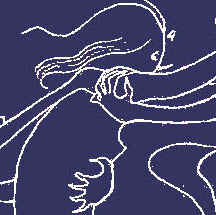Introducing the Artist
Romaine Brooks (1874-1970) was an American expatriate who spent most of her life in Europe, where her inherited wealth afforded her the opportunity to be a professional artist. She is most famous for her portraits of women who challenged society's beliefs about traditional female roles during the early twentieth century. Her self-portrait, in which she portrayed herself as a proud lesbian dressed in chic men's clothing (left) in particular has spawned a veritable cult following. With a sustained income she had no reason to be prolific and towards the end of her life, her production dwindled. Prior to her death she made a generous donation of twenty-three paintings and thirty-seven drawings to the national collection (National Collection of Fine Arts, now the Smithsonian American Art Museum). Her career as an artist was rediscovered in 1971 with the exhibition of this body of works, along with some important examples from European collections. Since then, her artwork has been displayed in over eighteen well received exhibitions, in America and abroad. Our knowledge of her survives through these works and in her own words within the pages of her unpublished memoirs appropriately titled No Pleasant Memories since they recollect her nightmarish childhood as a personal narrative of survival. Through the efforts of a select few art critics, art historians, and her biographer, she remains an influential part of art history.
When her biographer, Meryle Secrest, wrote the introduction to Between Me and Life she began with, "The work of Romaine Brooks cannot be separated from her life. It had its roots in experiences that marked and marred her and provided the obsessive themes for her portraits and drawings."1 Upon reading her biography and her extremely personal memoirs, I found this statement felt accurate. To emphasize the connection between Brooks’ life and art, Secrest carefully chose a selection of drawings to illustrate her biography. Additionally, she quoted directly from Brooks’ memoirs at length, further emphasizing the autobiographical aspects of the images. Similarly, the goal of this webpage is to publically share a selection of Brooks' drawings in context with this autobiographical material to increase awareness of Brooks' remarkable and very personal contribution to art history.

"No Pleasant Memories"
Quotes from the unpublished memoirs of Romaine Brooks
According to the 1986 Director of the National Museum of American Art, Charles C. Eldredge, “Brooks’ life was an act of reduction to the barest essentials.”2 Since her life and art cannot be separated, it is no surprise that her drawings were also reduced to the “barest essentials”3 of line. The resulting images are a collection of continuous contour line drawings. By regularly using the same technique in each work and ignoring the changes in contemporary art movements, Brooks’ drawings are stylistically consistent and easily recognizable from her early years as a student through her later years as a professional artist. Additionally, her choice of themes was also consistent. Some of the most prevalent describe her family dynamic, especially the relationship she had with her mother and brother. The most reoccurring theme addresses her lifelong struggle to be independent. She frequently uses the formal quality of the continuous contour line to illustrate the restrictive nature of her upbringing and later to illustrate her attempts to break free. Her drawings range from literal interpretations of childhood experiences to more imaginative interpretations of the emotional abuse her family put her through. According to her memoirs, Brooks believed that she drew, “to ease…the sorrows of retrospection.”4 They were her escape and ultimately her salvation from her afflicted childhood. Otherworldly beings are frequent characters in her works illustrating her constant battle against her inner and outer daemons. Using her works, we can analyze her life as a veritable pictorial autobiography conveying the strong relationship between her artistic imagery and the events of her past.
Footnotes
Meryle Seacrest. Between Me and Life: A Biography of Romaine Brooks. (Garden City, N.Y: Doubleday, 1974), xvii.↑
Adelyn D.Breeskin. Romaine Brooks. Washington D.C.: Distributed for the National Museum of American Art, Smithsonian Institution, by the Smithsonian Institution Press, (1986), 38. Originally written in Catalog of an Exhibition of Original Drawings by Romaine Brooks (Chicago: The Arts Club of Chicago, 1935).↑
Adelyn D.Breeskin. Romaine Brooks. Washington D.C.: Distributed for the National Museum of American Art, Smithsonian Institution, by the Smithsonian Institution Press, (1986): 9. Forward written by Charles C. Eldredge, Director of The National Museum of American Art 1986.↑
Brooks,Romaine. No Pleasant Memories , c. 1930. Unpublished manuscript, Archives of American Art, (Smithsonian Institute: Washington DC), 6-7.↑